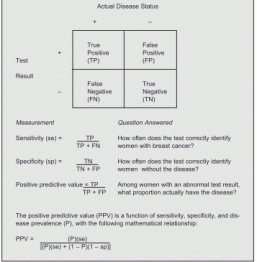Theory and principles of cancer screening
BOX 1-1
Definitions of Screening Test Performance
Actual Disease Status
The performance of a screening test is often defined by three related measurements: sensitivity, specificity, and positive predictive value. The sensitivity of a screening test is the proportion of people with the disease who test positive. Specificity is the proportion of people without the disease who test negative. There is often a trade-off between sensitivity and specificity, with an increase in one leading to a decrease in the other. The positive predictive value is the portion of individuals with a positive screening test result who actually have the disease. If screened individuals are assigned a position in a two-by-two classification scheme on the basis of their disease status and test result, values for the three measurements can be calculated as follows:
The methods used to assess the efficacy of a screening method are quite different from the approach used to assess new treatments. For instance, treatment outcome is often measured by using short-term surrogate end points that have previously been correlated with long-term outcome, but such surrogate end points generally do not exist for screening methods.
